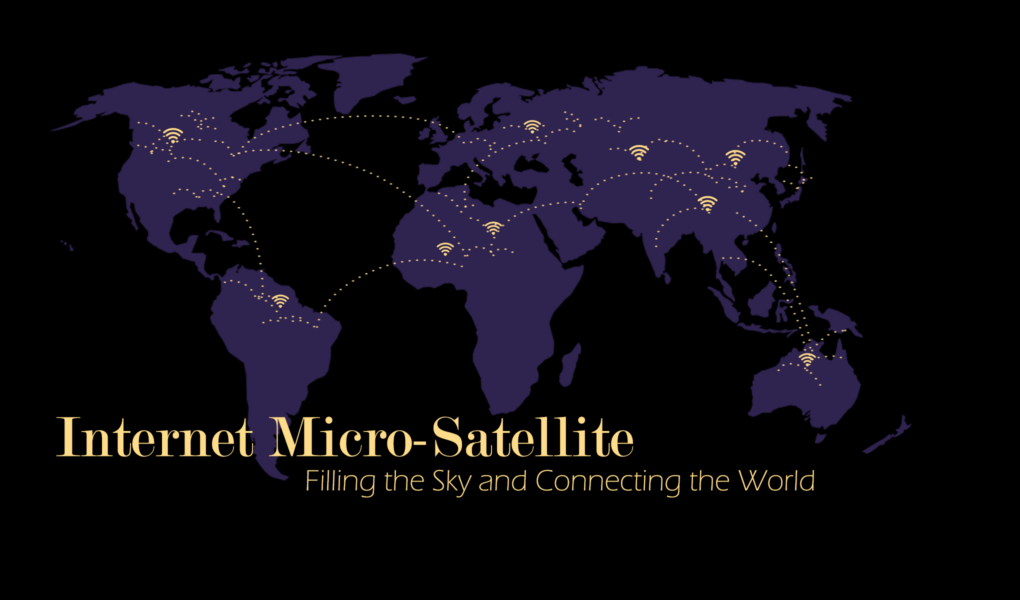Abstract
Internet micro-satellites are small communications satellites that provide an internet connection to customers anywhere in the world. They work together in thousand-strong groups to relay signals with minimal lag. This article provides an overview of the phenomenon, design considerations involved in building a successful constellation, and impacts these constellations will have.
Introduction
The last few years have seen an explosion in spaceflight activity. The world launched over a thousand satellites in 2020, a dramatic departure from the previous norm of 100-300 satellites. In 2023, that number ballooned to over 3000. This marked increase in space activity is the result of a new kind of satellite network, built to provide internet connectivity to customers anywhere in the world [1]. These satellite groups, referred to as “megaconstellations,” have the potential to transform our world, for better and for worse.

Figure 1: Objects in Earth orbit that weigh more than 100 kg. Starlink, an internet megaconstellation, takes up much of the total. [23]
Using Space to Communicate
Satellites have been helping to connect people across the world for over sixty years. In 1962, Telstar 1 became the first satellite to establish a communication relay in space. Before Telstar, radio waves had to be sent over the Earth’s surface between ground-based relays. Many ground-based relays were needed because each relay needed to maintain a direct line of sight to the next one. Relays in Earth’s orbit can see a huge fraction of Earth’s surface at once, allowing them to receive data from one continent and send it to another. Telstar 1 demonstrated this capability by exchanging television programs between the United States and Europe [2].
Since Telstar, most communications satellites have been stationed in geosynchronous orbit, a special type of orbit that allows a satellite to match speed with the Earth’s surface below [3]. Be cause they rotate in sync with the Earth, these satellites appear stationary in the sky, so they are easy to track and ideal for many services. While light travels quickly, the extreme distances involved result in noticeable lag, making geostationary satellites poor candidates for internet browsing, calls, or virtual meetings [4].

Figure 2: Low Earth Orbit in relation to Geosynchronous orbit
The Birth of the Satellite Constellations
The idea for internet constellations is not entirely new. About thirty years ago, there was a huge push to put communications satellites in low Earth orbit, a region of space much closer to Earth than geosynchronous orbit [5]. In these orbits, satellites pass overhead in a matter of minutes, so a constellation must have many satellites in order to keep a constant signal [3]. While this adds a layer of complexity, this orbit can provide internet connectivity with virtually no lag [4]. Seven companies tried to build constellations for low Earth orbit in the ‘90s, and three companies launched satellites. Unfortunately, the demand for global internet was not high enough to offset the massive costs associated with launching satellites, causing all three companies to declare bankruptcy [5].
In the late 2010s, as computers and cell phones became smaller and more efficient, satellites were doing the same thing. Several companies theorized that the market might support a satellite internet endeavor that took advantage of smaller, more capable satellites and a lower launch cost [5]. Of these, SpaceX’s Starlink network has been the first to market and the most well documented. SpaceX has already launched 6,800 satellites but plans to double that number in the coming years [6]. A few other companies have started launching satellites. Notably, Amazon plans for a sizable constellation, as does the company OneWeb. Both Amazon [7] and OneWeb [8] have already started launching satellites, but at lower volumes.
Designing a Functional Constellation
Part of the interesting design of these megaconstellations is how the satellites work together as a network. While each individual satellite functions as a simple relay, much like Telstar 1, there is an immense amount of work that goes into making sure the network functions at its best. For example, in addition to relay satellites, SpaceX operates around 150 ground stations which connect the satellite network to the regular internet. The constellation provides its users with internet access by connecting each user’s antenna to a ground station. The number of ground stations and their positioning throughout the globe can have a large impact on how well a constellation performs [9]. The amount of data each station can handle is limited, so increasing the number of stations is critical for speed and reliability. Distributing the ground stations throughout the globe is also important to ensure that satellites always have access to a station even when flying over remote regions.
Another important design consideration for a constellation is the altitude at which satellites operate. Lower altitudes provide less latency (delay) [9], at the expense of reduced longevity. If a satellite orbits too closely to the Earth, air drag will slow it down until it burns up in the atmosphere. In fact, Starlink satellites orbit low enough that they are occasionally lost when solar storms manipulate the Earth’s atmosphere [10]. To avoid the costs of launching replacement satellites, smaller constellations generally operate at higher altitudes to keep their satellites from re-entering the atmosphere at the expense of introducing more lag in the signal.
Another consideration for constellation design is orbital inclination. Inclination is a measure of how tilted an orbit is with respect to the equator. For example, a low inclination orbit would fly only over the equator while a high inclination orbit would travel over the poles. Amazon is planning to concentrate its satellites in inclinations that keep them flying over population centers, while SpaceX has prioritized covering as much of the globe as possible [9]. While Amazon will have more throughput where its customers are located, SpaceX’s network will work well from anywhere on the globe.
Advanced Tech Makes It Possible
In order to be effective and efficient, this generation of constellation satellites incorporates exciting new technologies. In order to fight constant drag in low Earth orbit, many internet constellation satellites use a new rocket engine called the hall-effect thruster [11][7]. These thrusters energize tiny amounts of xenon or argon using electricity before shooting this energized gas out of the engine at very high speeds. These engines require a lot of electricity, which can be continuously collected using a solar panel. The use of electricity allows hall-effect thrusters to operate with incredible efficiency, helping each satellite stay in orbit for longer while using less fuel [12].
Another recent development is the phased-array antenna. By varying the power across a grid of tiny antennas, this antenna can be digitally “steered” without physically moving the unit in a process known as “beamforming” [13]. This allows ground stations and satellites to precisely track each other without complex moving parts. Modern constellations use phased arrays on both the spacecraft and the terminals that connect customers to the network. Over the last few years, megaconstellation operators have reduced phased array production costs to 30 dollars per unit [5], which will enable it to be used in other exciting new technologies.
Though these constellations use radio waves to communicate with people and servers on the ground, they also benefit from recent developments in optical communications. Scientists have recently figured out how to encode massive amounts of data onto a precisely steered laser beam. This technology is useful for sending data between megaconstellation satellites [9]. For example, if one satellite is experiencing high traffic, it can transfer some of the load to a less busy satellite. Additionally, this method allows signals to hop around the network if a specific ground station is not available. Lasers are preferred to radio waves because they can carry more data at once. They also do not require a dedicated radio frequency, which is hard to obtain from regulators [14]. These recent developments, shown in Figure 3, allow constellation satellites to be cheaper and longer lasting. This enables the new generation of internet satellites to survive where the previous generation could not [5].

Figure 3: Typical mega-constellation satellite characteristics and technologies
Getting Them Up There

Figure 4: Starlink Satellites stacked up before release [22]
SpaceX is the current industry leader in internet satellites primarily because they provide their own launch services [3]. This allows them to design the perfect satellites for their workhorse rocket, the Falcon 9. Starlink satellites are flat square panels, about 3 meters across, stacked like pancakes inside the payload bay of the Falcon 9 rocket. Using this design, SpaceX can launch 60 satellites at a time [6].
To improve its economic efficiency, SpaceX reuses its boosters, landing the first stage on a barge after each Starlink launch [15]. This single action divides the launch cost by a factor of five [6]. Now that rocket boosters have been flown 20 times in a row with minimal refurbishment, several other companies are clamoring to add reusability into their future plans as well [16].
Artificial Stars

Figure 5: Satellite trails visible on an astronomical photograph [3]
Unfortunately, satellites in orbit interfere with astronomy. Astronomers warn that as Earth orbit is filled with satellites, it will become increasingly hard for them to do their jobs. Images captured by telescopes are incredibly light-sensitive, so when a sunlight-reflecting satellite passes through the frame, it leaves a streak of light on the image [17]. The effect is especially prominent when satellites are close, as internet mega constellation satellites are [18]. While some telescopes can record two images and digitally remove the satellite trails, this method fails when trying to capture split-second astronomical events such as when a far-away planet moves in front of its parent star [17].
The satellites are most visible close to dusk and dawn, when the search for near-earth asteroids takes place [19], so the long-term proliferation of constellation satellites may hamper our ability to find threatening asteroids. SpaceX has launched Starlink satellites that are painted black in an attempt to minimize their visibility [20], but astronomers have shown that they remain visible even to small observatories [19].
Space at a Premium?
As space becomes more crowded with satellites, it is worth asking if it will ever be too crowded. Some scientists think that once a critical mass of orbital debris is reached, a scenario known as “Kessler Syndrome” could unfold. According to the theory, once one piece of debris crashes into another, they create thousands of tiny pieces leading to a cascading effect and creating a dangerous feedback loop. Eventually, Earth orbit may become so full of trash that it is rendered entirely unusable [20].
This is unlikely to happen as a result of low-orbiting satellites like Starlink, because anything this close to Earth will fall out of orbit in a few years as a result of air drag [4]. Higher altitude internet satellites could definitely play a role in a Kessler Syndrome scenario, because objects at higher altitudes deorbit less readily.
Impact
It is clear that a market now exists for fast and reliable satellite internet. The proposal, to supply the internet to places where infrastructure does not support it, is an attractive one. In addition to increasing the safety of people in remote areas, the technology also has the potential to bring new users onto the internet for the first time. In areas where internet infrastructure does not exist, satellite internet is by far the most affordable way to get online.
This ability to operate in remote areas outside the reach of cellular networks also makes internet constellations incredibly valuable tools in politics and war. Ukraine has used Starlink to coordinate military plans, despite SpaceX’s attempts to disable units not being used for humanitarian activities. Recognizing the tactical value of its network, SpaceX created Starshield, a military-only version [3].
Internet megaconstellations will have profound impacts closer to home as well. In addition to providing service to individual customers, SpaceX has signed on to provide faster inflight Wi-Fi to several airlines. In the next year, SpaceX plans to start Direct to Cell (D2C) service, using 5G to directly communicate from satellites to individual cell phones [22].
As launch costs plummet even further, more and more bold ideas will become a reality. Just a few years ago, it seemed impossible to operate thousand-strong constellations of internet satellites. Today, it’s an integrated part of everyday life. In fifty years will we have lunar outposts? Massive space stations? Off-planet mining and manufacturing? Chances are, we’ll see all of them realized.
Further Reading:
https://www.space.com/29222-geosynchronous-orbit.html
https://www.technologyreview.com/technology/satellite-mega-constellations/
https://www.youtube.com/watch?v=tI8OqpkOVzs
https://www.youtube.com/watch?v=VIQr1UyhwWk
https://www.youtube.com/watch?v=Ztfph50vOhg
Works Cited
- “Online Index of Objects Launched into Outer Space,” Office for Outer Space Affairs, https://www.unoosa.org/oosa/osoindex/search-ng.jspx (accessed Sep. 11, 2024).
- J. Stromberg, “Fifty Years Ago Today, the First Communications Satellite Was Launched Into Space,” Smithsonian, Jul. 10, 2012. Available: https://www.smithsonianmag.com/smithsonian-institution/fifty-years-ago-today-the-first-communications-satellite-was-launched-into-space-1454520/
- A. Satariano, S. Reinhard, C. Metz, S. Frenkel, and M. Khurana, “Elon Musk’s Unmatched Power in the Stars,” The New York Times, Jul. 28, 2023. Available: https://www.nytimes.com/interactive/2023/07/28/business/starlink.html
- Inmarsat, “A straightforward introduction to satellite communications,” Inmarsat Corporate Website, 2023. Available: https://www.inmarsat.com/en/insights/corporate/2023/a-straightforward-introduction-to-satellite-communications.html
- T. Butash, P. Garland, and B. Evans, “Non‐geostationary satellite orbit communications satellite constellations history,” International journal of satellite communications and networking, vol. 39, no. 1, pp. 1–5, 2021, doi: 10.1002/sat.1375. Available: https://uosc.primo.exlibrisgroup.com/permalink/01USC_INST/273cgt/cdi_proquest_journals_2468809569
- National Aeronautics and Space Administration, “NASA Space Science Data Coordinated Archive,” National Aeronautics and Space Administration, 2022. Available: http://nssdc.gsfc.nasa.gov
- Amazon, “Amazon’s Project Kuiper demonstrates safe, controlled satellite maneuvering on orbit,” Aboutamazon.com, Nov. 09, 2023. Available: https://www.aboutamazon.com/news/innovation-at-amazon/amazon-project-kuiper-satellite-propulsion-system-november-2023-update (accessed Sep. 12, 2024).
- OneWeb, “OneWeb confirms successful deployment of 16 satellites including next-generation JoeySat,” Oneweb.net, May 10, 2023. Available: https://oneweb.net/resources/oneweb-confirms-successful-deployment-16-satellites-including-next-generation-joeysat
- N. Pachler, E. F. Crawley, and B. G. Cameron, “Flooding the Market: Comparing the Performance of Nine Broadband Megaconstellations,” IEEE wireless communications letters, pp. 1–1, 2024, doi: 10.1109/LWC.2024.3416531. Available: https://uosc.primo.exlibrisgroup.com/permalink/01USC_INST/273cgt/cdi_crossref_primary_10_1109_LWC_2024_3416531
- H. Seo, “A solar storm blasted 40 SpaceX satellites out of orbit,” Popular Science, Feb. 10, 2022. https://www.popsci.com/science/spacex-loses-starlink-satellites-solar-storm/
- D. Y. Oh and P. Neumann, “A year of firsts for electric propulsion,” Aerospace America, vol. 61, no. 11, pp. 52-, 2023.https://aerospaceamerica.aiaa.org/year-in-review/a-year-of-firsts-for-electric-propulsion/ (accessed Sep. 12, 2024).
- D. Goebel and I. “Katz, Fundamentals of Electric Propulsion: Ion and Hall Thrusters,” Jet Propulsion Laboratory, 2008. Available: https://descanso.jpl.nasa.gov/SciTechBook/series1/Goebel__cmprsd_opt.pdf
- Viasat, “What’s so special about phased array antennas?,” viasat.com, Dec. 18, 2023. https://news.viasat.com/blog/corporate/whats-so-special-about-phased-array-antennas (accessed Sep. 12, 2024).
- A. K. Majumdar, Laser communication with constellation satellites, UAVs, HAPs and balloons : fundamentals and systems analysis for global connectivity. Cham, Switzerland: Springer Nature Switzerland AG, 2022. Available: https://uosc.primo.exlibrisgroup.com/permalink/01USC_INST/hs9vaa/alma991043808495503731
- S. Clark, “SpaceX’s most-flown reusable rocket will go for its 20th launch tonight,” Ars Technica, Apr. 12, 2024. https://arstechnica.com/space/2024/04/spacexs-most-flown-reusable-rocket-will-go-for-its-20th-launch-tonight/
- [3] Danton, J. Bezerra, Alison, and C. Henrique, “Innovative and low-cost launch systems,” Elsevier eBooks, pp. 403–419, Jan. 2023, doi: 10.1016/b978-0-12-824541-5.00005-4. Available: https://uosc.primo.exlibrisgroup.com/permalink/01USC_INST/hs9vaa/alma991044157428003731
- R. Massey, S. Lucatello, and P. Benvenuti, “The challenge of satellite megaconstellations,” Nature astronomy, vol. 4, no. 11, pp. 1022–1023, 2020, doi: 10.1038/s41550-020-01224-9. Available: https://uosc.primo.exlibrisgroup.com/permalink/01USC_INST/273cgt/cdi_crossref_primary_10_1038_s41550_020_01224_9
- J. C. McDowell, “The Low Earth Orbit Satellite Population and Impacts of the SpaceX Starlink Constellation,” Astrophysical journal. Letters, vol. 892, no. 2, pp. L36-, 2020, doi: 10.3847/2041-8213/ab8016. Available: https://uosc.primo.exlibrisgroup.com/permalink/01USC_INST/273cgt/cdi_crossref_primary_10_3847_2041_8213_ab8016
- A. Witze, “SpaceX tests black satellite to reduce ‘megaconstellation’ threat to astronomy,” Nature (London), vol. 577, no. 7790, pp. 303–303, 2020, doi: 10.1038/d41586-020-00041-4. Available: https://uosc.primo.exlibrisgroup.com/permalink/01USC_INST/273cgt/cdi_proquest_miscellaneous_2338991380
- J. Kelvey, “Understanding the misunderstood Kessler Syndrome,” Aerospace America, Mar. 01, 2024. Available: https://aerospaceamerica.aiaa.org/features/understanding-the-misunderstood-kessler-syndrome/
- D. Grossman, “With SpaceX’s Starlink, Astronomers Fear They Are Losing the Fight To Preserve the Night Sky,” Popular Mechanics, Jun. 04, 2019. Available: https://www.popularmechanics.com/space/satellites/a27722305/starlink-satellite-astronomers/
- Starlink, “Satellite Technology,” Starlink, 2024. https://www.starlink.com/technology
- A. Witze, “2022 was a record year for space launches,” Nature (London), vol. 613, no. 7944, pp. 426–426, 2023, doi: 10.1038/d41586-023-00048-7. Available: https://uosc.primo.exlibrisgroup.com/permalink/01USC_INST/273cgt/cdi_proquest_miscellaneous_2765071488



